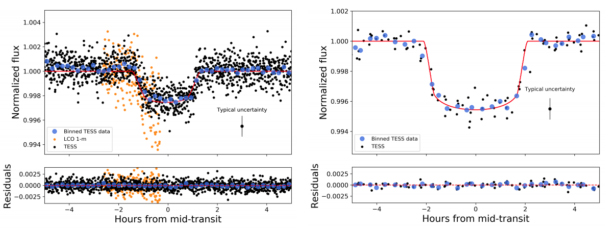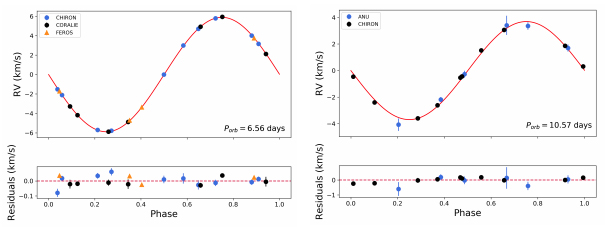Editor’s note: Astrobites is a graduate-student-run organization that digests astrophysical literature for undergraduate students. As part of the partnership between the AAS and astrobites, we occasionally repost astrobites content here at AAS Nova. We hope you enjoy this post from astrobites; the original can be viewed at astrobites.org.
Title: Two intermediate-mass transiting brown dwarfs from the TESS mission
Authors: Theron W. Carmichael et al.
First Author’s Institution: Harvard University
Status: Accepted to AJ
Brown dwarfs are objects with masses 13–80 times the mass of Jupiter but roughly the same radius (0.7–1.4 Jupiter radii). The lower mass limit separates them from planets: unlike planets, brown dwarf cores are massive enough to fuse deuterium. On the other hand, if they get too massive (80 Jupiter masses) then their cores start to fuse hydrogen and they become a main sequence star.
Similarly to a planet, when a brown dwarf passes in front of its host star, it causes a dip in the star’s light curve. This allows us to detect brown dwarfs with missions like the Transiting Exoplanet Survey Satellite (TESS).
Brown Dwarf Desert
Because of their Jupiter-like radius and larger mass, brown dwarf transits should be as easy to detect as giant planets — yet there are only 23 known transiting brown dwarfs. The lack of known transiting brown dwarfs is known as the “brown dwarf desert”. The answer to this problem may lie in their formation mechanism — whether they form like stars or like planets. Accurate measurements of mass, radius and orbital parameters are necessary to understand the formation and evolution of brown dwarfs.
Today’s paper reports the discovery of two new transiting brown dwarfs with reliable measurements of mass, radius, and age. With ages greater than 3 Gyr, they are the oldest transiting brown dwarfs with well-constrained measurements.
Brown Dwarfs and Stellar Parameters
The authors observed two targets of interest (TOIs) with TESS and the Las Cumbres Observatory (LCOGT). Figure 1 shows the transit light curves for the two host stars: TOI-569 and TOI-1406.

Figure 1: Left: TESS and LCO light curve for TOI-569. Right: TESS and LCO lightcurve for TOI-1406. Both lightcurves include the EXOFASTv2 transit model in red. [Adapted from Carmichael et al. 2020]
Spectroscopic observations for TOI-569 were taken using the CHIRON echelle spectrograph, as well as the CORALIE and FEROS spectrographs. Spectra for TOI-1406 were obtained with CHIRON and the echelle spectrograph on the Australian National University (ANU) telescope. The resulting RV curves are shown in Figure 2.

Figure 2: Left: RV curve for TOI-569. Right: RV curve for TOI-1406. Both RV curves include the EXOFASTv2 model in red. [Adapted from Carmichael et al. 2020]
The authors also used EXOFASTv2 to fit the stellar parameters like age and mass using isochrone models. The brown dwarf is assumed to have the same age as the host star. TOI-569b and TOI-1406b have ages of 4.7 Gyr and 3.2 Gyr, respectively.
Mass–Radius Diagram
One way to test brown dwarf evolutionary models is using a diagram of mass vs. radius. Unlike a star, the deuterium-fusing core of a brown dwarf does not produce enough energy to fight gravitational collapse, causing the radius of the dwarf to decrease as it ages. This means that a brown dwarf of a certain age has an expected location in a mass–radius diagram. If you have an independent measurement of the brown dwarf age, then you can change the isochrone model parameters to match the observed position of the brown dwarf.

Figure 3: Mass–radius diagram for the known transiting brown dwarfs. The different colored curves show substellar isochrone models for different ages. The newly discovered brown dwarfs are shown as the red and cyan points. [Carmichael et al. 2020]
Figure 3 above shows the mass–radius diagram for transiting brown dwarfs, focusing on those with accurate ages. The black points in Figure 3 have well-measured ages from star clusters. The addition of TOI-569b and TOI-1406b to the diagram allows the authors to test, for the first time, substellar isochrones for populations older than 2.5 Gyr.
TESS has so far allowed the discovery of 4 new transiting brown dwarfs and may find as many more in the future. However, many more discoveries are needed to fully understand the formation and evolution of brown dwarfs.
About the author, Gloria Fonseca Alvarez:
I’m a third year graduate student at the University of Connecticut. My current research focuses on the inner environments of supermassive black holes.


2 Comments
Pingback: Tranzytujące brązowe karły wykryte z pomocą TESS – PTMA Kraków
Pingback: Tranzytujące brązowe karły wykryte z pomocą TESS – Astronomia Śląska